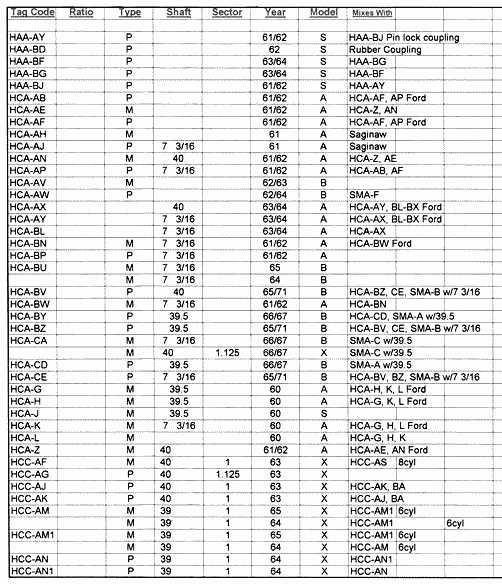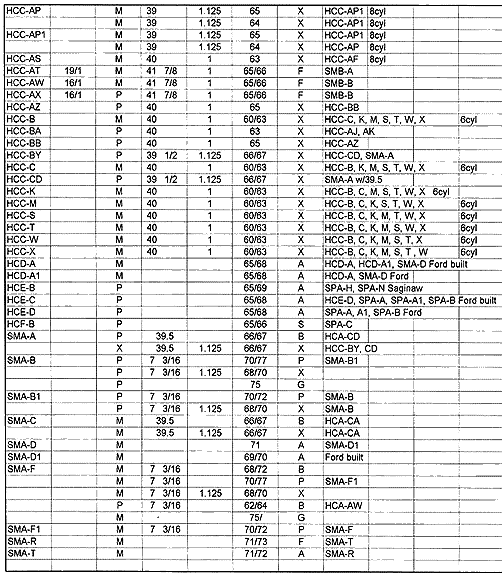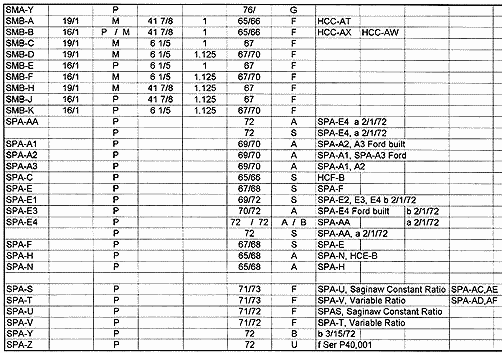PLACE AN ORDER |
StangerSite © 2008 All pictures, diagrams, text and illustrations are the property of StangersSite and may not be copied or reproduced without the express written permission of the Webmaster |
STEERING SYSTEM |
STEERING BOX ID TAG DECODER |
Passenger Car Steering Box Codes 1960-1979 |
MODEL CODES: |
A = Galaxie & big Fords F = Mustang & Fairlane P = Maverick & Comet U = Bronco |
B = Fairlane G = Granada S = Thunderbird X = Falcon & Comet |
TYPE CODE: M = Manual Steering P = Power Steering SHAFT: Length SECTOR: Diameter RATIO: Box Internal Ratio MIXES WITH: Functionally, the same box |

Most Ford steering boxes have a metal ID tag attached to them by one of the top cover
plate bolts. The top line is the ID Tag Code of the box. The charts on the following pages are listings of Ford passenger car steering boxes from 1960-1979. The first part of the second line is the Assembly Date Code listing the date the box was assembled - not the day it was installed in the car. After the date code is the Shift Code, indicating the work shift during which the box was assembled that day. |
The date code follows standard Ford date decoding. The first position is a number
indication the Year of build. Decoding the ID Code on the tag shown above shows
that the box was installed in 1965-1966 Mustangs, so the first digit '6' means the box was assembled in 1966. The second position is a letter indicating the month the box was built. |
Using the tag shown above as an example, the ID Code (HCC-AW) shows the application
to be for a 1965-1966 Mustang with Power Steering and a 16:1 ratio. |
A = January B = February C = March D = April E = May F = June |
G = July H = August J = September K = October L = November M = December |
On the example tag, the letter ' F ' indicates that the box was built in June. The third and forth positions are the day the box was built. On the example tag
the numbers ' 17 ' indicate that the box was built on the 17th. So, the box for the example tag was built June 17, 1966, during the ' B ' work shift. |
FORD NEVER USED THE LETTER 'I ' IN THEIR DATE CODING SINCE IT WAS EASILY CONFUSED WITH THE NUMBER ' 1 ' |
ID TAG CODE |
ASSEMBLY DATE CODE |


Steering boxes were built in batches by code. It is not unusual for Mustangs all
across the country to have HCC-AT steering boxes all assembled within a 3 or 4
day span. We have seen boxes come in from all over the country for rebuild and
notices that many of the same ID code have exact or similar date codes. |
NOTES: |
Comparing the casting dates on the steering box housings, often boxes were built
from 3 to 10 days after being cast up. Mustangs especially were being built so
fast that it seemed that the cases barely had time to cool down before they were
being used to build new boxes. |
MUSTANG Steering Box Differences |
March 1964 to early 1967 used 41 7/8" long Input Shaft Later 1967 to August 1970 used 6 3/16" long Input Shaft March 1964 to 5/1/67 1967 used 1.000" diameter Sector Shaft 5/1/67 1967 to August 1970 used 1.125" diameter Sector Shaft 1965-1970 Steering Boxes came in only two ratios: 16:1 Quick Ratio - used on Power steering and all GT's 19:1 Slow Ratio - used on Manual Steering cars |
1965 - 1966 GT Steering Box |
Mustangs equipped with a special option "handling package", which included all factory
GT-equipped Mustangs and K-code Mustangs, came with "quick-ratio" steering
setup. Part of this package was a quicker ratio steering box to reduce steering
wheel movement when turning. This was accomplished by installing the 16:1 ratio steering box in the car. If the car had Power Steering, it already had the quick ratio box which received the normal power steering ID
tag code. If the car was equipped with Manual Steering, the quick ratio box was installed and received a special ID tag code. There is no special GT steering box for a power steering equipped car. They simply received the same identical box as all other power steering cars. The only special GT steering box was one installed in a manual steering car. The ID tag is a unique code that only came in GTs. The only difference between the power steering 16:1 box and the GT manual steering 16:1 box was the bearing load and gear mesh settings when it was built. It was set up just a little bit tighter since a manual steering box has more strain on it and tends to loosen up more than a power steering box. |
Pitman Arms: (3590) |
1965-1966 6cyl Manual 1965-1966 6cyl Power 1965-1966 V8 Manual & Power 1967 6cyl & V8 Power built before 5/1/67 with 1.0" sector 1965-1966 Shelby only (Quick Steer Kit) 1967 6cyl & V8 Manual built before 5/1/67 with 1.0" sector 1967-1970 6cyl & V8 Manual built after 5/1/67 with 1.125" sector 1967-1970 6cyl & V8 Power built after 5/1/67 with 1.125" sector 1971-1973 6cyl & V8 Manual 1971-1973 6cyl & V8 Power |
Long Shaft / Short Shaft |
Ford changed the Mustang steering box from a long shaft to short shaft for two reasons: the short shaft box was needed for cars with tilt-wheel options and for the coming introduction of the collapsable steering column. |
MUSTANG Steering Box Castings & Interchange |
Box Housing: 1965-1967 Mustangs with the 1.0" sector shaft used the C4DR-A casting, which is a Falcon casting .Later in 1966, Ford went to a C6ZR-A casting 1967-1970 Mustangs with the 1.125" sector shaft used the C7ZR-A casting housing, though some used a C4DR-B Falcon casting also |
Long Shaft Boxes: All long input shaft boxes used an Adjustment Nut with the long snout and no rubber seal. Bcause of this, the top of the box is vented through the top input shaft bearing, so it uses a non-vented grease fill plug Short Shaft Boxes: All short input shaft boxes used an Adjustment Nut that was very short and had a rubber seal mounted in it around the input shaft. Since this style box could not vent through the bearing and seal, they were equipped with vented grease fill plugs. |